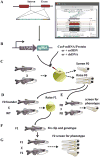Zebrafish Genome Engineering Using the CRISPR-Cas9 System
- PMID: 27836208
- PMCID: PMC5127170
- DOI: 10.1016/j.tig.2016.10.005
Zebrafish Genome Engineering Using the CRISPR-Cas9 System
Abstract
Geneticists have long sought the ability to manipulate vertebrate genomes by directly altering the information encoded in specific genes. The recently discovered clustered regularly interspaced short palindromic repeats (CRISPR)-Cas9 endonuclease has the ability to bind single loci within vertebrate genomes and generate double-strand breaks (DSBs) at those sites. These DSBs induce an endogenous DSB repair response that results in small insertions or deletions at the targeted site. Alternatively, a template can be supplied, in which case homology-directed repair results in the generation of engineered alleles at the break site. These changes alter the function of the targeted gene facilitating the analysis of gene function. This tool has been widely adopted in the zebrafish model; we discuss the development of this system in the zebrafish and how it can be manipulated to facilitate genome engineering.
Keywords: CRISPR–Cas9; genetic screen; genome editing; knock-in; knockout; zebrafish.
Copyright © 2016 Elsevier Ltd. All rights reserved.
Figures



References
-
- van der Oost J, et al. CRISPR-based adaptive and heritable immunity in prokaryotes. Trends Biochem Sci. 2009;34:401–407. - PubMed
-
- Wright AV, et al. Biology and Applications of CRISPR Systems: Harnessing Nature's Toolbox for Genome Engineering. Cell. 2016;164:29–44. - PubMed
-
- Barrangou R, et al. CRISPR provides acquired resistance against viruses in prokaryotes. Science. 2007;315:1709–1712. - PubMed
Publication types
MeSH terms
Grants and funding
LinkOut - more resources
Full Text Sources
Other Literature Sources

